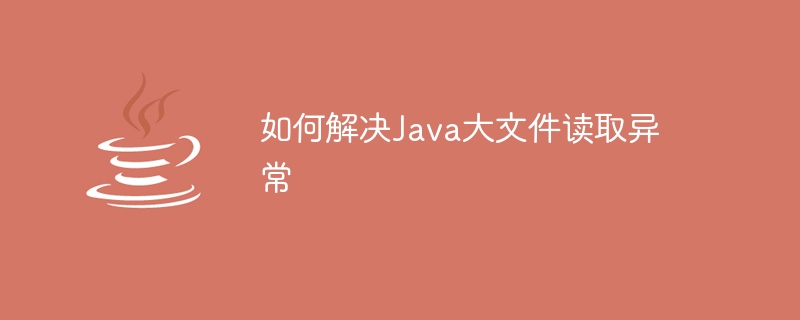
Methods to solve Java large file reading exceptions: 1. Use streaming processing; 2. Use MappedByteBuffer; 3. Use block reading; 4. Use parallel processing; 5. Adjust the JVM heap size; 6 , Use database or external storage; 7. Optimize code and data structures; 8. Use external tools and libraries; 9. Monitoring and analysis tools; 10. Continuous learning and improvement. Detailed introduction: 1. Using streaming processing, Java8 introduces the concept of streaming processing, allowing you to process data in a declarative manner, etc.

The operating system for this tutorial: Windows 10 system, DELL G3 computer.
When processing large files in Java, you may encounter a memory overflow (OutOfMemoryError) exception. This is because loading the entire large file into memory at once may cause insufficient memory. In order to solve this problem, you can use the following methods:
1. Use Stream Processing: Java 8 introduces the concept of stream processing, allowing you to declaratively way to process data. For large files, you can use streaming to read the file line by line or block by block, rather than loading the entire file at once. For example, you can use Java's BufferedReader class to read a file line by line.
try (BufferedReader br = new BufferedReader(new FileReader("largefile.txt"))) {
String line;
while ((line = br.readLine()) != null) {
// 处理每一行数据
}
} catch (IOException e) {
e.printStackTrace();
}2. Use MappedByteBuffer: MappedByteBuffer is a class in Java NIO that can map files into memory and implement memory-mapped files. This method can reduce memory usage and improve file reading and writing efficiency.
RandomAccessFile raf = new RandomAccessFile("largefile.txt", "r");
FileChannel channel = raf.getChannel();
MappedByteBuffer mbb = channel.map(FileChannel.MapMode.READ_ONLY, 0, channel.size());3. Use chunked reading (Chunked Reading): Divide the large file into multiple small blocks, and then process these small blocks one by one. This approach avoids loading the entire file into memory at once. You can use Java's FileInputStream and BufferedInputStream classes to implement chunked reading.
try (FileInputStream fis = new FileInputStream("largefile.txt");
BufferedInputStream bis = new BufferedInputStream(fis)) {
byte[] buffer = new byte[1024]; // 定义块大小
int bytesRead;
while ((bytesRead = bis.read(buffer)) != -1) {
// 处理缓冲区中的数据
}
} catch (IOException e) {
e.printStackTrace();
}4. Use parallel processing: If your application is multi-core and can process different parts of the file in parallel, then consider using parallel processing. You can break a large file into smaller chunks and process those chunks simultaneously in multiple threads. This can make full use of the performance of multi-core CPUs and speed up file processing. However, it should be noted that parallel processing may cause synchronization problems between threads and needs to be handled with caution.
5. Adjust the JVM heap size: If none of the above methods can solve the problem, you can also try to adjust the JVM heap size. By increasing the size of the heap, more data can be accommodated. You can set the maximum heap size through the JVM parameter -Xmx. Note, however, that increasing the heap size may increase garbage collection overhead and may cause other problems. Therefore, there are trade-offs when sizing the heap.
6. Use a database or external storage: For very large files, you may want to consider storing them in a database or external storage instead of directly in memory. This avoids out-of-memory issues while providing better data management and query capabilities. However, this approach increases the complexity of the system and requires careful consideration.
7. Optimize code and data structures: Sometimes, the root of the problem may not be the size of the file, but the efficiency of the code and data structures. Check whether your code can be optimized, such as using more efficient data structures or algorithms. This may include reducing unnecessary memory allocations, reusing objects, optimizing loops, etc. By optimizing code and data structures, you can reduce memory usage and improve program performance.
8. Use external tools and libraries: Some external tools and libraries are specifically designed to handle large files. They may provide more efficient ways to read, process and analyze large files. . For example, distributed computing frameworks such as Hadoop and Spark can handle large-scale data sets, including large files. Consider using these tools and libraries that may help solve your problem.
9. Monitoring and analysis tools: Using monitoring and analysis tools can help you diagnose problems. For example, Java's VisualVM tool can help you monitor memory usage, analyze heap dumps and thread stacks, and more. Other tools such as JProfiler, YourKit, etc. can also provide more in-depth analysis and monitoring functions. With monitoring and analysis tools, you can better understand your program's memory usage so you can find the root cause of the problem and take appropriate action.
10. Continuous learning and improvement: Technology continues to develop, and new tools and methods continue to emerge. Continuously paying attention to and learning new technologies and methods can help you solve similar problems and improve your skills and knowledge. Networking and sharing experiences with other developers is also a great way to learn and improve. Through continuous learning and improvement, you can better cope with various challenges and improve your development capabilities.
The above is the detailed content of How to solve Java large file read exception. For more information, please follow other related articles on the PHP Chinese website!
